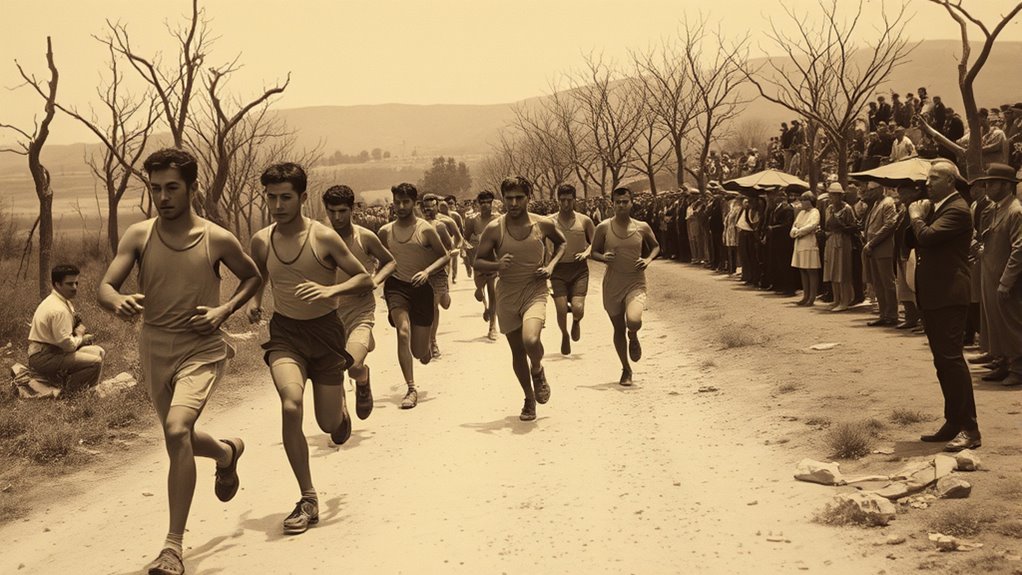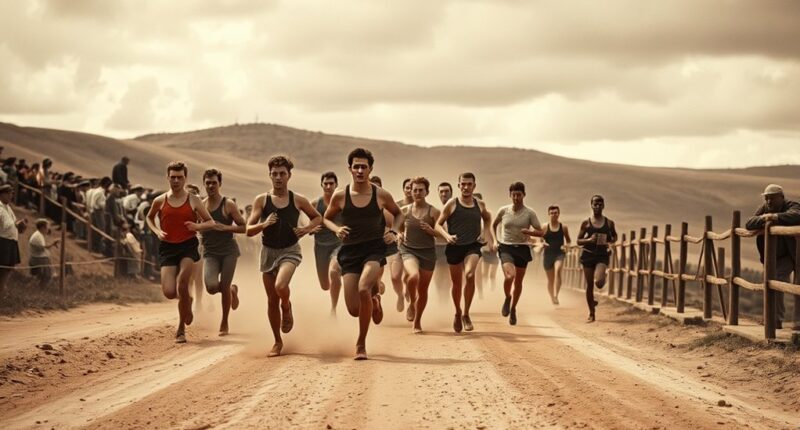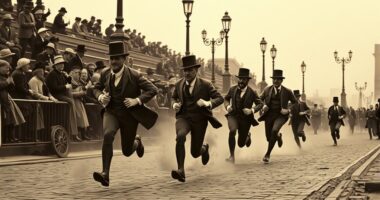The 1896 Olympic marathon, inspired by Greek legend, marked the start of modern endurance racing and set the stage for future competitions. Athletes relied on willpower and instinct, with little scientific training, to complete the race from Marathon to Athens. This historic event demonstrated physical endurance and mental resilience, inspiring generations of runners. If you want to understand how this legendary race shaped marathon history and strategies, keep exploring the story behind it.
Key Takeaways
- The 1896 Athens marathon was the first modern Olympic marathon, inspired by Greek legend and symbolizing athletic endurance.
- Early runners relied on intuition and basic training, focusing on endurance without scientific methods.
- Spyridon Louis famously maintained a steady pace to win, establishing effective race strategies.
- Modern marathon training emphasizes pacing, nutrition, and structured workouts, contrasting with 1896 practices.
- The 1896 race’s legacy inspires contemporary athletes and highlights the importance of endurance and strategy in marathons.

Did you know that the first modern Olympic marathon took place during the 1896 Athens Games? This historic race marked the beginning of what has become one of the most iconic events in sports. The marathon’s origins are rooted in legend, inspired by the Greek messenger Pheidippides, who supposedly ran from Marathon to Athens to deliver news of a vital victory. For the athletes competing in 1896, this race was more than just a test of endurance—it was a chance to make history. You might wonder how they prepared for such a demanding challenge, especially since marathon training back then was primitive compared to today’s standards. Without modern sports science, runners relied heavily on sheer willpower, experience, and instinct. They focused on building endurance through long runs, often with little structured training plans. Today, athletes develop detailed race strategies to optimize their performance, but in 1896, many competitors simply ran based on feel and personal experience.
Understanding race strategies is essential if you want to excel in marathons, whether you’re competing or just curious. The key is pacing yourself—knowing when to conserve energy and when to push harder. The 1896 race showcased this beautifully, with the winner, Spyridon Louis, maintaining a steady pace that kept him strong until the finish. His approach contrasted sharply with some of the other runners who started too fast and faded later. Modern marathon training emphasizes this balance, combining long runs, interval training, and proper nutrition to prepare the body for race day. Successful marathon training isn’t just about running a lot; it’s about developing a sustainable pace, managing fatigue, and avoiding injury. These principles are rooted in understanding your body’s limits and adjusting your race strategies accordingly.
If you’re considering running a marathon, learning from this history helps you appreciate the importance of preparation and strategy. The 1896 race was a test of both physical endurance and mental resilience. Today’s marathon runners benefit from advanced training methods, but the core idea remains the same: pacing yourself and maintaining the right race strategies can make all the difference. As you train, focus on building a solid endurance base, practicing race-day nutrition, and experimenting with your pacing. Remember, every marathoner starts somewhere—just like the pioneers of 1896—and with dedication, you can conquer the distance. The legacy of that first Olympic marathon lives on, inspiring runners worldwide to push their limits and achieve their goals.
Frequently Asked Questions
How Did the Marathon Distance Become Standardized?
You might not realize it, but the marathon measurement became standardized in 1908 when the race distance was set at 26.2 miles. This race distance standardization happened to guarantee the race fit within the viewing area of the Olympic stadium and to create consistency. Since then, officials agreed on this specific race distance, making it the official marathon measurement worldwide and ensuring every marathon follows the same race distance.
Who Were the Key Figures Behind Organizing the 1896 Marathon?
You should know that Greek organizers, led by Evangelis Zappas and the Greek government, played a vital role in planning the 1896 marathon. Pierre de Coubertin, the founder of the modern Olympic Games, also helped organize the event, emphasizing the significance of athletic spirit. Together, these figures guaranteed the marathon’s success, setting the stage for its inclusion and standardization in future Olympics.
What Challenges Did Runners Face During the 1896 Race?
You face tough weather conditions, with heat and dust making the race exhausting, and no modern hydration stations to help. During the race, you might suffer runner injuries like cramps or exhaustion, which could slow you down or force you to drop out. These challenges test your endurance and resilience, making the 1896 marathon a grueling event that pushed runners to their physical limits.
How Has Marathon Training Evolved Since 1896?
Imagine training for a marathon today, where technological advances like GPS watches and specialized shoes help you optimize your performance. Since 1896, training improvements have transformed how runners prepare. Athletes now integrate structured workouts, recovery strategies, and nutrition plans, unlike the basic routines of early runners. These innovations have made marathon training more efficient, safer, and scientifically grounded, helping you achieve your best while reducing injury risks.
What Was the Public Reaction to the 1896 Marathon?
You’d find that the public excitement for the 1896 marathon was immense, capturing everyone’s attention. Media coverage spread rapidly, highlighting the race’s drama and the remarkable achievement of Spyridon Louis. People were inspired by the endurance and determination shown, fueling interest in long-distance running. This enthusiastic response helped elevate the marathon’s status, turning it into a celebrated Olympic event and inspiring future generations of athletes.
Conclusion
Now, as you imagine running that historic 1896 marathon, you realize how it all started with a bold idea and a bit of old-school grit—no smartphones or GPS, just sheer determination. That race set the stage for today’s global event, proving that with enough passion, even a barefoot runner can change history. So next time you hit the pavement, think of Pheidippides and the epic journey that kicked off the modern marathon.









